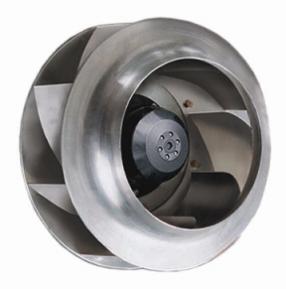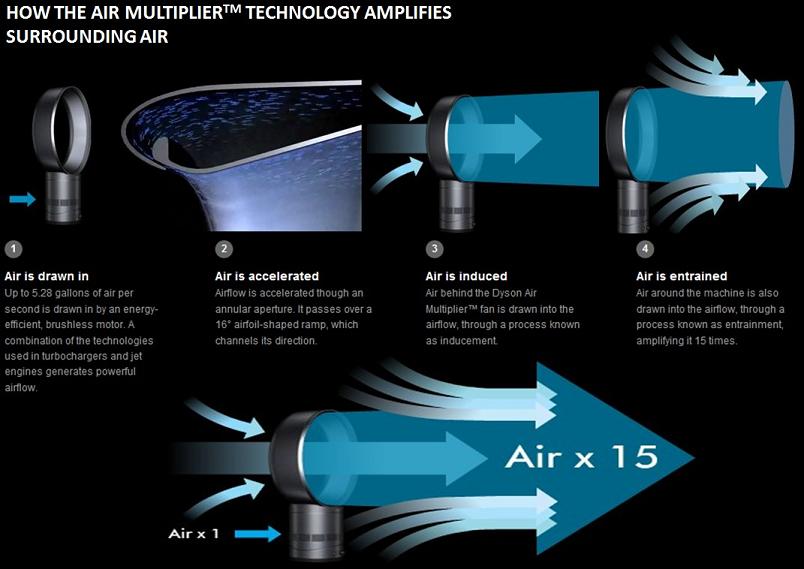Sir James Dyson was born on May 2 1947 in Cromer, Norfolk, England. He was one of three children, whose father was Alec Dyson.
James Dyson attended Gresham's School in Holt, Norfolk, from 1956 to 1965. He attended the Byam Shaw School of Art from 1965 to 1966. He attended the Royal College of Art in London from 1966 to 1970, and studied furniture and interior design. He went on to study engineering.
In 1968, Dyson married Deirdre Hindmarsh, an art teacher. The couple have three children: Emily, Jacob and Sam.
In 1997, James Dyson was awarded the Prince Phillip Designers Prize. In 2000, he received the Lord Lloyd of Kilgerran Award. In 2005, he was elected as a Fellow at The Royal Academy of Engineering. He was appointed a Knight Bachelor in the New Year's Honours December 2006.
In 2002, Dyson set up the James Dyson Foundation to support design and engineering education among young people.
Dyson Products
Description of the product
Air is sucked in through the base by a 40 watt electric motor, and then pushed out at high speed through a lip which runs around the inside of its circular head.
As this is forced out, other air is drawn into the airflow, resulting in the expulsion of 405 litres every second.
The fan also has a dimmer-type switch, which means the powerful current can be easily controlled.
Without blades, curious children will not catch their hands in it, and the simple design makes it easy to clean.
At 1 metre high and only 19 centimetres wide, the AM02 Tower is slender and running track shaped to take up limited floor space.
Around 33 litres of air are drawn in each second and amplified 16 times using Air Multiplier technology.
The AM03 Pedestal draws in 33 litres of air per second and amplifies the air 18 times.
The machine extends from a height of 1.2 metres to 1.4 metres for use in larger areas including living rooms and offices.

Business Profile
 |
| OFFICIAL LOGO |
James Dyson invented many things before he struck gold and became famous for his work with vacuum cleaners. His first invention was the sea truck, which launched in 1970, and sold for upwards of $500 million. Following this, Dyson worked with modifying wheelbarrows, making a Ballbarrow, a wheelbarrow that used a ball instead of a wheel. He went on to invent the Trolleyball, a trolley that launched boats, and the Wheelboat.
It was in the 1970s that Dyson started his work with vacuum cleaners. He had the idea to use cyclonic separation for vacuums so that they would not have to lose suction during cleaning. His idea came about because he was frustrated with his own Hoover vacuum; dirt would fill up and clog the bag and then the vacuum would lose suction.
In 1983, after five years of development and over 5,000 prototypes, Dyson launched the G-Force cleaner in Japan through catalogues. His product couldn't launch in his native UK because distributors and manufacturers didn't want to disturb the cleaner-bag market. Despite this set back, Dyson received the 1991 International Design Fair prize in Japan.
In 2006, Dyson launched a hand dryer with an air stream of 400 mph. James Dyson is a shining example of how an idea or invention can make you a successful entrepreneur and business person. In 2008, it was estimated that his work was worth over £1 billion and his invention has revolutionised not only the vacuum cleaner world but the appliances world in general.
How the Business Started
Dyson did manage to begin making and selling what was called the "G-Force" vacuum cleaner in Japan in 1986, and it emerged as a cult favorite, despite its rather high price tag. But then he was forced to begin suing other companies for patent infringement, and the cases dragged on for years and nearly bankrupted him. Finally, in the early 1990s he was able to build a factory in the Wiltshire area of England, after obtaining a business loan from a local bank; several other financial institutions had turned him down, but allegedly the bank manager's wife had tried his vacuum cleaner and was thrilled with it. The Dyson DC01 vacuum cleaner went on the market in Britain in 1993, and by early 1995 was the best-selling vacuum cleaner in the country. It had so many fans that it eventually entered the permanent collections of the Design Museum of London, the Victoria & Albert Museum, the Design Museum of Zurich, and Paris's Centre Georges Pompidou, and has also collected a long list of industrial-design awards.
When Dyson launched his product in the United States in 2002, he began to appear in television ads for it. At a retail price of $399, the Dyson Dual Cyclone was a hit with American consumers as well, and by early 2005 had captured 20 percent of the vacuum-cleaner sales market. His company, based in Wiltshire, remains a privately held one, and Dyson himself is thought to be worth an estimated $1 billion.
How the business gain succes?
Retaining the patent, he tried to raise money for research and then production, by selling licences to America and Japan. The Japanese market was a success, with the machine being sold as the 'G Force' and produced in pastel pink, it became a luxury status symbol selling at £1,200 per machine.
America was not a success, because after a licence agreement was terminated, a gargantuan manufacturer began production and marketing a cyclonic vacuum cleaner under its own name. James took out a lawsuit and fought against the company for five years.
James Dyson took his small business idea, from a cereal box and masking tape, to the instantly recognisable, stylish Dyson Dual Cyclone cleaner. Now, James heads his company, Dyson, which is turning over £100 million. James Dyson vacuum cleaners are known worldwide.
The Ups and Downs of the Business
Relating to his own experiences on designing his vacuum cleaner, Dyson admits that he didn’t make a perfect prototype immediately after he came up with the idea of using cyclone technology to improve vacuum cleaners. Instead, it took 5127 prototypes and 15 years to create a working model. During the process, he came upon tough times as funds ran low. Despite these challenges, Dyson continued to work on his prototypes.
Even after Dyson’s first marketable product was completed, his work was not yet done. He and his team continues to improve their vacuum cleaners, as they are currently on their 35th iteration of their original marketed product.
As every iteration is completed, Dyson and his team finds that there is always something that could be improved. Dyson describes the design process as continuous and never-ending, endlessly frustrating, yet enormously rewarding at the same time. Thus, Dyson is no stranger to failure, and he does not let failure intimidate him. Instead, he welcomes it.
In 1991, it won the International Design Fair prize in Japan, and became a status symbol there.Using the income from the Japanese licence, James Dyson set up the Dyson company, opening a research centre and factory in Wiltshire, England, in June 1993. His first production version of a dual cyclone vacuum cleaner featuring constant suction was the DC01, sold for £200. Even though market research showed that people wouldn’t be happy with a transparent container for the dust, Dyson and his team decided to make a transparent container anyway and this turned out to be a popular and enduring feature which has been heavily copied. The DC01 became the biggest selling vacuum cleaner in the UK in just 18months.
After the introduction of the cylinder machine, DC02, DC02 Absolute, DC02 De Stijl, DC05, DC04, DC06 and DC04 Zorbster, the root Cyclone was introduced in April 2001 as the Dyson DC07, which uses seven smaller funnels on top of the vacuum. By 2009, Dyson began creating other air-powered technologies, the AirBlade hand drier, the Air Multiplier bladeless fan and Dyson Hot, the bladeless fan heater.
Dyson Strategies: Where Strategy and Analysis Converge
Experts say that the last recession officially starts in December 2007 so declines in gross domestic product begin earlier in the calendar year. So, what are the ingredients of Dyson’s success during an economic downturn? Here are some “stratelytical” insights for their vacuum cleaner sales successes:
• Dyson diversifies into other product lines, such as handheld vacuums, personal fans and hand dryers. This helps boost sales of the flagship offering. For example, someone who decides to wash their hands after using a bathroom at a restaurant is most likely relieved to dry their hands in a Dyson Airblade hand dryer instead of another hand dryer. This creates a positive association for the end-user and makes them consider buying a Dyson vacuum cleaner. This person may be interacting with a specific product, but they are having associations about the entire brand.
• Outbreak fears from E.coli, swine flu and other diseases create an incredible global focus on preventative self-health actions. Investing now in a state-of-the-art vacuum cleaner or hand dryer can minimize the spread of parasitic germs. This may be less expensive than visits to the doctor or hospital in the long-term.
• The complexity of Dyson’s product technology is simply communicated through market-facing touchpoints, ranging from the Dyson Ball in the vacuum cleaners to the airflow power from the Dyson Airblade. Videos of these touchpoints are in the right hand navigation bar. This form of transparency increases level of customer confidence for the Dyson brand. This can be translated into higher sales and profits for the company.
The company’s latest innovation is a handheld fan called the Dyson Air Multiplier. This fan does not have any blades: http://cli.gs/8u5HYR. It is exclusively available at the Dyson online store and certain design stores. Dyson is a company to watch as it “airs” more innovations in the short-and-long-term.
Archivements
Milestones:
1974: Strikes out on his own to develop the Ballbarrow. Designs a water-filled plastic garden roller
1977: The Ballbarrow wins the Building Design Innovation Award.
1978: James invents the Trolleyball - a boat launcher with ball wheels.
1978: James stumbles across the idea of a bagless cleaner while renovating his country house
1979: Spends five years developing the cleaner, and builds 5,127 prototypes of the Dual Cyclone™ .
1981: Files U.S. Patent application
1982: James Dyson spends two years trawling, looking for someone to license the product.
1983: Dyson produces his first prototype vacuum cleaner, a pink machine called the G-Force
1985: Dyson takes his product to Japan where he begins to work with company that imports Filofax.
1986: The Japanese start to sell the G-Force
1992: Patent # 5,090,976 (US) issued 1992 for Dual cyclonic vacuum cleaner
1995: The Dyson DC01 becomes the best-selling vacuum cleaner in the UK.
1995: The Dyson Dual Cyclone™ DC02 is launched, and becomes the second highest seller
1996: Launches DC02 Absolute, the first with both HEPA filtration and a bacteria-killing screen.
1997: James Dyson's autobiography 'Against the Odds' is published
2001: New Root Cyclone technology is the most powerful upright vacuum cleaner on the market.
2005: The Dyson DC15 (The Ball™) replaces conventional wheels with a ball.
2002: Duson brings Western Europe's top-selling vacuums to the United States Dyson, James Dyson, cyclonic, vacumm cleaner, dual cyclone, inventor, biography, profile, history, inventor of, history of, who invented, invention of, fascinating facts.
Unique Feature about Dyson
THE CHALLENGE
Electric fans haven’t changed since they were invented in 1882. Different materials, new buttons and the addition of grills, but still the same problem – the blades chop the air before it hits you. That’s why they cause unpleasant buffeting. The solution? Take the blades out, and the buffeting stops. But how can a fan work without blades?

THE SOLUTION
Dyson engineers started with pressurized air, forcing it through narrow apertures to create jets. But they needed it to be more powerful to work in a fan. The breakthrough came when they noticed that accelerating air over a ramp amplified it by 10 – 20 times, drawing in surrounding air through processes known as inducement and entrainment (think of an airplane wing). Hundreds of iterative tests revealed the ideal ramp angle, aperture width and loop amplifier dimensions.

Example of an impeller

- No blades makes it the safest fan on the market
- Light and easy to move and adjust






0 comments:
Post a Comment